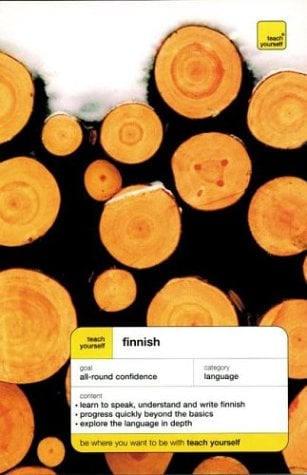For many language learners out there, the Teach Yourself series is probably the first thing that comes to mind when considering learning a new language. The best thing about the series (in my opinion) is that they have made beginner's language courses for just about any language you might want to learn. The method employed in Teach Yourself language courses is pretty decent, but not all Teach Yourself books are created equally. While the basic structure for all of their modern language courses is the same, differences in each author’s approach can really mean the difference between a great book, and a horrible one. Today I will be sharing my thoughts with you on what I consider to be one of the most outstanding titles from Teach Yourself – Complete Finnish.
Now, many people are already with the Teach Yourself series, but may not be familiar with their latest publications given the re-branded “Complete” titles. Just in case you were wondering, there is no huge difference between the “Complete” edition and the versions that came before it. It’s basically the exact same book content-wise, with just a few additions and a little bit of cleaning up around the edges. In short, if you already have an earlier version of Teach Yourself Finnish and were hoping for something completely revamped and exciting – you won’t find it here. With that said, I think you are probably better off getting the new “Complete Finnish” version as opposed to an older edition, as it’s fairly cheap in the first place, and you might as well benefit from the new updates, as insignificant as they may be.

One will notice right away that Complete Finnish is a bit different from other Teach Yourself books, as it is notably thicker. Flipping through the pages, you will see that there is very little fluff, as far as things like cheesy clip-art and word searches (though both are present in small amounts), and the majority of the book is made up of solid content.
I found the introductory sections of this book to be somewhat weak. Most of the essential information is given, but the sentences are a little disjointed, and the guidance on how the book should be used and how learning should be approached is very noncommittal. It gives a few tips, but ultimately suggests you should know how to study by now, so just do what you think is right for you. For use in a classroom setting, I would definitely recommend teachers write a precise explanation of how students should approach their studies using this book.
There is a nice introduction given on the background of the author, and it does it seem like she has a good amount of experience in the field of language instruction, which helps inspire confidence in the content of the text. The pronunciation section provides English equivalents, for which the author was kind enough to point out that they are based on British English, but there is no IPA (International Phonetic Alphabet). I would say the pronunciation section is sufficient (there are 10 pages dedicated to it) when supplemented with the accompanying audio, but I am still somewhat disappointed that there is no IPA included, nor any explanation of how the sounds should be articulated. For sounds which have no English equivalent, she simply writes “No English equivalent” and nothing more.
For those of you who aren’t already familiar with the Teach Yourself series, here is the basic format you can find in this book (and most of their other language courses):
·Dialogue(s) (or narrative in later chapters)
·Vocab list
·Culture and Language notes
·Grammar
·Exercises
·Another dialogue
·[Possibly more exercises]
·10 Things to Remember (this section is unique to this book as far as I have seen)
I will now go into my evaluation of each of these sections.
I have split feelings about the dialogues in this book. Each chapter has several dialogues at the beginning which cover the same basic topic. For instance, in the beginning, you will find many different dialogues illustrating all the different ways to greet someone. In a later chapter you can see several examples of communication demonstrating people giving and asking for directions. This is quite ideal for a beginner, and I wish more textbooks did things this way because it lets you see the same basic interactions expressed in several different ways. Most textbooks will give you only one dialogue per topic, which is quite unrealistic, considering there are always many different ways to say the same thing.

While I really like what the author did here with including an abundance of dialogues for each topic, I am still slightly put off by the fact that they are mainly all “task-based” interactions. What I mean by “task-based” is that the dialogues are trying to teach you some kind of skill to use the language like a tool. For instance, buying groceries at the store, asking for directions, ordering at a restaurant, etc. This is a feature which plagues every Teach Yourself book I have encountered, as well as most introductory language texts. The problem is, most of your communication in a foreign language is probably going to be casual talk between friends and acquaintances. Not only is this probably the most frequent form of communication, it’s the most rewarding as well — I don’t think people learn a language to connect with the culture by purchasing train tickets or ordering sausage from the market. How are you supposed to connect with people if your only language skills are for getting people to give you what you want, and asking them to help you with your problems?
Especially in a country like Finland, where most of the populous would be completely comfortable in helping you out with these things in English (and chances are they will speak English to you anyway if they see you struggling), it’s just not realistic to focus solely on task-based language from the beginning. I will restrain myself from going on further about this, but the point is that it’s kind of too bad. There’s nothing really special to say about the audio. Like any other Teach Yourself book, it’s kind of annoyingly formatted, but it does its job in terms of letting you hear the dialogues spoken and the sound and voice acting quality is better than what comes with your average introductory course.
Moving on to the vocabulary lists that follow each dialogue – this has never been a strength of the Teach Yourself series, and it proves somewhat frustrating in this book as well. The words are organized in order of appearance in the dialogues (which is good), but there is a problem with how each word is presented. Basically, instead of listing each word individually and providing an appropriate definition/explanation, the author has decided to group certain words into phrases and present it as one big chunk. Some examples are “Mitä kuuluu – how are you?”, “puhun suomea ja ruotsia – I speak Finnish and Swedish”, “mieluummin kapupungiss kuin maalla – to prefer the town to the countryside”. This frustrates me because I want to know what each individual word means, and how it acts as an agent in the phrase. Don’t get me wrong – it is still useful to list things as a phrase as the author has done here, but I don’t see why she didn't bother to break out the words of each phrase individually (preferably in both the form they appeared and the dictionary form). When used in a classroom setting, students would greatly benefit if instructors provided such a glossary.
One real strength the book has are the solid culture and language notes that come after the dialogue and vocab in each chapter. The author does a great job at tying the language into culture to teach you about Finland and Finnish culture. She even offers several useful URLs throughout the book for those who want to learn more about the things she is talking about. Language notes focus on clarifying usage of phrases, explaining when one should use certain phrases, how Finns normally react or respond to particular situations, and how ideas are expressed differently in Finnish and English. There is definitely a wealth of information to be had in these brief notes found in the middle of each chapter.
"One real strength the book has are the solid culture and language notes that come after the dialogue and vocab in each chapter. The author does a great job at tying the language into culture to teach you about Finland and Finnish culture."
In the midst of these great sections on Finnish language and culture, however, lies one of the book’s greatest faults – formatting. What I mean by this is the way that these sections are organized and laid out within the book. While the sections containing the dialogues and vocabulary are very clear and easy to follow, there is a horrible lack of formatting for the rest of every chapter. There are no clear titles or indications of where culture notes, language notes, and grammar explanations start and end. In other words, it’s like all three of these sections seem to bleed into each other with no clear sign of what text pertains to what kind of information. Some learners may not find this to be a great issue, but to me it makes the text seem unorganized and overwhelming. If I want to find the grammar explanations for a certain section, I can’t rely on sections or titles with bold lettering that clearly indicate to me the topic at hand. Instead, I have to scan through the entire text until I can find what I am looking for. With just a little bit more formatting, such as including clear titles that say “Culture Notes”, “Grammar”, “Conjugating verbs in the present tense”, etc. this book could have been made a lot easier to navigate, and feel a lot less burdensome to go through.
The grammar explanations are fairly thorough, giving plenty of examples and tables to illustrate usage and morphology. My only problem with the grammar sections is that they could have been organized better. For instance, the book will say something like “you saw several examples of the partitive case in this chapter, but we won’t be learning how to use this until later on in the book.” If you are going to show us several examples of it, why don't you just teach us how it works? Instead of teaching the grammar as it arises, the author tends to pick and choose which grammar points to explain. I suppose this is one way to structure a language text, and she does eventually get around to teaching all the grammar needed for a beginner, but I personally would rather have everything explained outright.
The exercises in this book could certainly use some work. Instead of the typical substitution drills, conjugation and inflection practice, fill in the blank, etc. you find almost exclusively task-based and translation exercises (which I find the least useful). For example, the text will ask you something like “How would you say _______ in Finnish?”; “What does _______ mean in English?” I find these kinds of exercises to be extremely ineffective. I would have preferred it if she had provided more exercises that let you practice inflecting words and playing with the grammar. At least there is a key in the back of the book which gives you the answers for all the exercises.

There is a section at the end of each lesson called “Ten Things to Remember”. It basically just provides the Finnish and English for ten useful phrases you should remember from content that was presented in the lesson. I don’t really get the point of this, because, if you had actually worked through the lesson until you got everything down, you should already know these ten things, and if you hadn't you would hardly be able to move on to the next section. In short, while completely harmless, it is just another gimmick.
At the end of the book there is a key to the exercises, Finnish-English and English-Finnish glossaries, appendixes, an index, and a glossary of grammatical terms. Most notably, however, there is a note from the author titled “Taking it further”. This is a small section detailing how you can continue to improve your Finnish now that you have completed the course. She offers several URLs to useful websites, and suggests several resources and strategies one can use to continue learning. I really wish all language textbooks had a section like this, especially for introductory texts which don’t have an associated text to continue on with.
"Students will need a lot of time and patience to work through some of these dialogues and grammar sections, as they offer a lot of information in a tiny space"
Although I spent a lot of time harping on all the flaws of this book, I have to admit that it really isn’t all so bad. I guess, more than anything, I am just disappointed that, with a tiny bit more polish, this could have been one of the learning materials period, not just the best of Teach Yourself. In the end, it all comes down to the content of the book, and how that is going to facilitate the student's learning of Finnish. In that aspect, I think the book delivers, giving you much more than you would expect from a Teach Yourself book. Students will need a lot of time and patience to work through some of these dialogues and grammar sections, as they offer a lot of information in a tiny space, but the endeavor should be made easier with guidance from an instructor. One really has to recognize the awesome job the author did with the amount of content and all the little extras she added throughout the book. You can tell that she’s not just trying to make the book so that Teach Yourself has one more thing to sell, but that she really cares about trying get people to learn Finnish. With that, I give my stamp of Recommended to this book. Though it is not without flaw, I believe it could prove an invaluable asset to any beginning Finnish learner.
For teachers: As I pointed out in my review, there is plenty of content within the book to keep students busy, but there are some missing points that an instructor should readily be able to supplement. Try helping students digest the information more easily by making some well-formatted printouts and providing them a clear plan of study so that they don't get overwhelmed in the vastness of the book.
For students: I wouldn't bother with most of the exercises, unless you personally find them interesting or rewarding. Try studying the grammar patterns taught throughout the book and making your own sentences based on the examples, then ask your teacher to double check your sentences for accuracy. I think you will find this helps give you a better grasp of the exotic quality of Finnish grammar.






